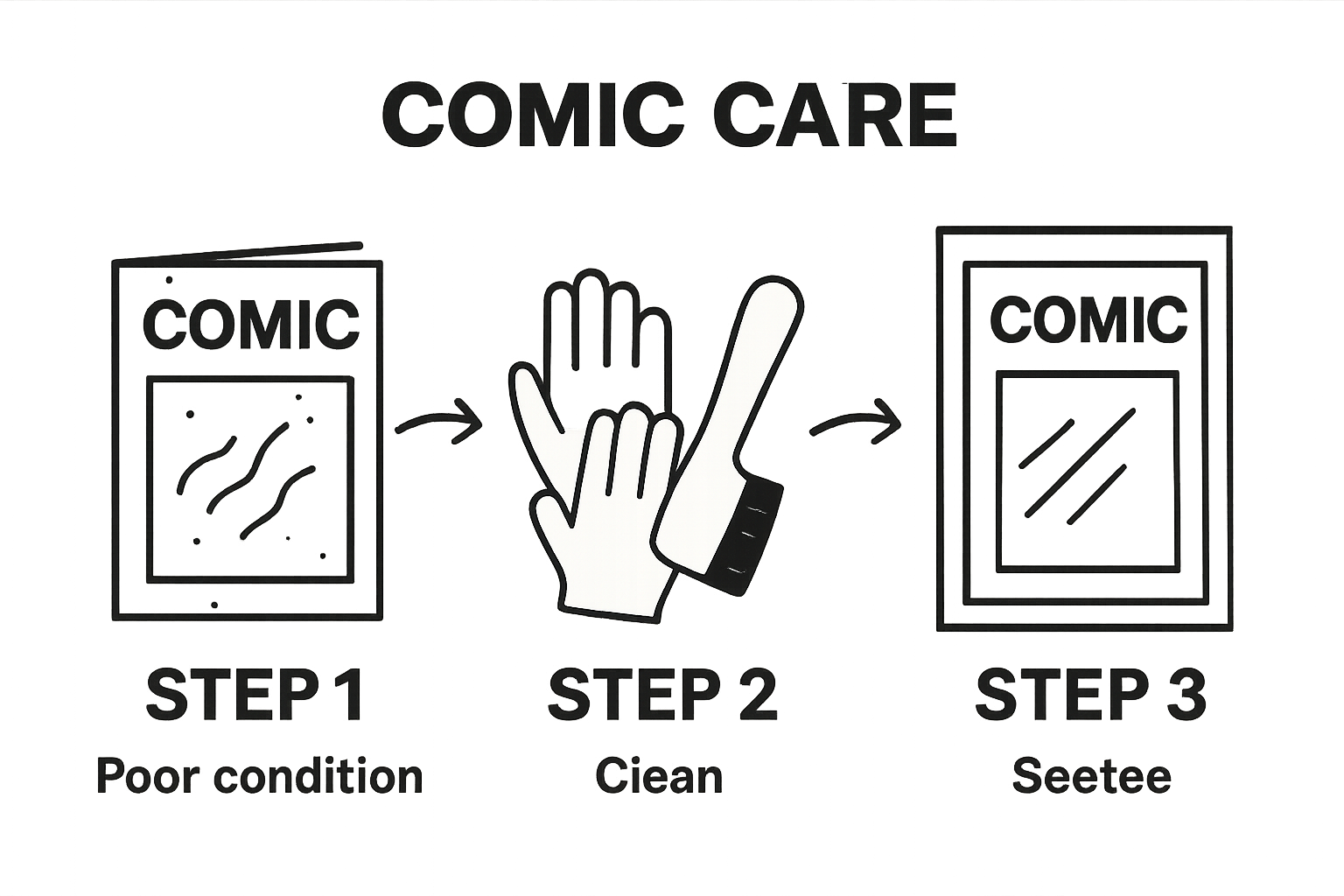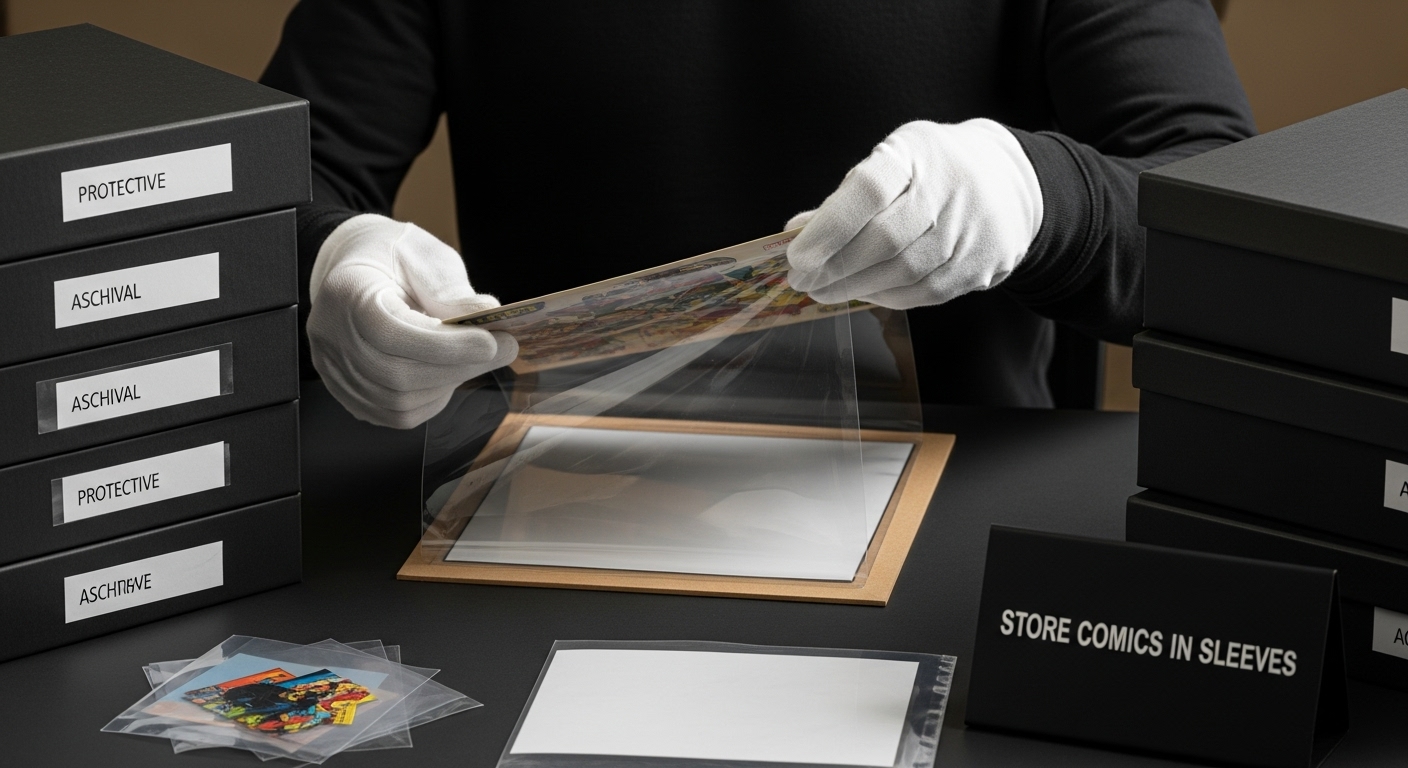How to Care for Comics: Essential Tips for Preservation
Comic book collections can soar in value, with some rare issues selling for over six figures at auction. Most people think preserving comics is all about keeping them in a plastic sleeve on a shelf. That barely scratches the surface. True comic book preservation demands secrets the pros use, and a single mistake can ruin decades of history.
Table of Contents
- Step 1: Assess The Condition Of Your Comics
- Step 2: Gather Essential Care Supplies
- Step 3: Clean And Handle Comics Safely
- Step 4: Store Comics In Protective Sleeves
- Step 5: Organize And Display Your Collection
- Step 6: Regularly Review And Maintain Your Comics
Quick Summary
| Key Point | Explanation |
|---|---|
| 1. Assess comic condition thoroughly | Examine each comic for signs of degradation to understand preservation needs and prevent irreversible damage. |
| 2. Use high-quality archival supplies | Invest in Mylar sleeves and acid-free backing boards to protect comics from environmental and physical damage. |
| 3. Handle comics with care | Use gloves and specialized tools to minimize contact and avoid damages during cleaning and handling. |
| 4. Store comics vertically in archival boxes | Prevent spine stress and maintain integrity by storing comics upright, avoiding horizontal stacking. |
| 5. Schedule regular maintenance reviews | Perform biannual inspections to assess condition changes and adapt preservation strategies accordingly. |
Step 1: Assess the Condition of Your Comics
Preserving comic books begins with a careful initial assessment that determines their current state and potential preservation needs. Understanding the physical condition of your comics is crucial before implementing any preservation strategy. Not all comics age the same way, and recognizing early signs of degradation can prevent irreversible damage.
Start by examining each comic under good lighting, preferably natural daylight or a bright, soft white light that reveals details without creating harsh shadows. Handle the comic with clean, dry hands or wear soft cotton gloves to prevent transferring oils and dirt. Look for telltale signs of wear such as page discoloration, brittleness, spine stress, corner bending, or microscopic tears along the edges.
Careful inspection requires methodical observation. Systematically check the front and back covers, then gently flip through each page, supporting the spine to prevent additional stress. Pay special attention to these critical areas:
- Cover integrity and color preservation
- Page discoloration or yellowing
- Spine alignment and binding condition
- Edge wear and potential paper fragmentation
- Signs of moisture damage or mold
Documenting your findings is as important as the assessment itself. Create a detailed inventory noting each comic’s condition, using a simple rating system that helps track potential conservation needs.
 According to Library of Congress preservation guidelines, comics showing advanced degradation might require professional conservation techniques.
According to Library of Congress preservation guidelines, comics showing advanced degradation might require professional conservation techniques.
Remember that environmental factors significantly impact comic preservation. Humidity, temperature fluctuations, and direct sunlight can accelerate deterioration. A comprehensive assessment isn’t just about current damage but also understanding potential future risks to your collection. By taking time to thoroughly evaluate each comic’s condition, you’re laying the groundwork for effective long-term preservation.
Step 2: Gather Essential Care Supplies
After carefully assessing your comic book collection, the next critical step is assembling the right preservation tools. Professional comic preservation requires specialized supplies that protect your valuable collectibles from environmental damage and physical degradation. Think of this process as creating a defensive shield for your comics, guarding against time, humidity, and potential mishandling.
Professional conservators recommend investing in high-quality archival materials specifically designed for comic book protection. Mylar sleeves and acid-free backing boards form the cornerstone of an effective preservation strategy. These specialized materials create a protective barrier that prevents direct handling damage and minimizes chemical interactions that can cause paper deterioration.
Select comic-grade protective sleeves made from virgin polyethylene or polypropylene, which offer superior clarity and chemical stability. Avoid standard plastic sleeves, as they can contain acids that gradually damage paper. Your preservation kit should include multiple types of protective gear:
- Archival-grade Mylar or polypropylene comic sleeves
- Acid-free backing boards
- Archival storage boxes
- Soft cotton gloves
- Precision tweezers
- Soft, lint-free microfiber cloths
According to Smithsonian Institution conservation guidelines, choosing the right storage materials is crucial for long-term comic preservation. Purchase archival-quality supplies from specialty comic preservation retailers or professional art conservation suppliers. While these materials might seem expensive, they represent a critical investment in protecting your collection’s value and historical integrity.
Below is a table summarizing the essential supplies needed for comic preservation, including the type, preferred characteristics, and their specific purpose.
| Supply | Preferred Characteristics | Purpose |
|---|---|---|
| Mylar sleeves | Archival-grade, virgin polyester | Provides durable protection from handling, dust, and moisture |
| Acid-free backing boards | Lignin-free, acid-free | Supports comics, prevents bending and degradation |
| Archival storage boxes | Acid-free, sturdy | Stores comics vertically, reduces environmental stress |
| Soft cotton gloves | Lint-free, clean | Prevents transfer of oils and dirt during handling |
| Precision tweezers | Non-abrasive, fine-tip | Handles delicate edges or small tears safely |
| Microfiber cloths | Lint-free, soft | Removes surface dust and debris without scratching |
Remember that consistency is key in comic book preservation. Once you’ve gathered your supplies, create a dedicated preservation workspace with good lighting, stable temperature, and minimal dust. This preparation sets the stage for implementing careful, systematic protection techniques that will help your comic collection withstand the test of time.
Step 3: Clean and Handle Comics Safely
Handling comic books requires a level of precision and care that goes beyond ordinary document management. Improper handling can cause irreversible damage to even the most pristine collectibles, making this step crucial in your comic preservation journey. Your goal is to minimize physical contact while ensuring thorough, gentle cleaning that preserves the comic’s structural integrity.
Begin by creating a clean, controlled environment free from dust, direct sunlight, and potential contaminants. Wear soft cotton gloves to prevent oil and dirt transfer from your skin to the comic’s delicate surfaces. The oils from human hands can cause permanent discoloration and gradual paper degradation, making protective hand covering non-negotiable for serious collectors.
Cleaning techniques demand a delicate touch. Use specialized tools designed for archival preservation:
- Soft, natural-hair brushes with gentle bristles
- Compressed air in short, controlled bursts
- Lint-free microfiber cloths
- Precision tweezers for rare handling
According to Smithsonian Institution conservation guidelines, surface dust removal should be performed with extreme caution.
Hold comics by their edges, supporting the entire page when turning to prevent unnecessary stress on the binding. Avoid liquid cleaners completely - even seemingly harmless cleaning solutions can cause permanent staining or paper breakdown.
When moving comics, always support the entire comic’s weight. Never pull or drag pages, and minimize the frequency of handling. Each interaction introduces potential risk, so treat every comic as a fragile historical artifact. After cleaning, immediately place the comic in its protective sleeve with an acid-free backing board, ensuring a stable, controlled environment that minimizes future degradation risks.
Step 4: Store Comics in Protective Sleeves
Protective sleeves represent the frontline defense in preserving your comic book collection’s condition and value. Proper sleeving is more than a simple packaging step - it’s a critical preservation technique that shields your comics from environmental threats, physical damage, and gradual degradation.
Choosing the right sleeve requires careful consideration. Not all protective sleeves are created equal. Look for archival-grade materials specifically engineered for comic book preservation. Virgin polyethylene and polypropylene sleeves offer superior protection, creating a barrier against dust, moisture, and potential handling damage. Avoid cheap, generic plastic sleeves that might contain acids capable of slowly deteriorating your comics.
The sleeving process demands precision and patience. Begin by ensuring your comics are completely clean and free from surface debris. Carefully slide the comic into the sleeve, supporting its entire weight and avoiding any unnecessary bending or stress. Always pair your sleeve with an acid-free backing board to provide additional structural support and prevent page warping.
Consider these critical aspects when selecting and applying protective sleeves:
- Material quality and archival grade
- Clarity and transparency
- Thickness and durability
- Size compatibility with specific comic book dimensions
- Long-term chemical stability
According to Library of Congress preservation guidelines, professional-grade protective sleeves made from virgin polyester or polyethylene offer the most reliable protection against environmental degradation. These specialized sleeves create a microclimate that significantly reduces the risk of paper breakdown, discoloration, and structural damage.

After sleeving, store comics vertically in archival boxes to prevent spine stress and maintain their structural integrity. Avoid horizontal stacking, which can cause uneven pressure and potential permanent deformation. By implementing these meticulous protective measures, you’re not just storing comics - you’re actively preserving valuable pieces of artistic and cultural history.
Step 5: Organize and Display Your Collection
Organizing and displaying your comic book collection transforms preservation from a technical process into an art form. A well-curated collection tells a story beyond individual comic books, creating a visual narrative that reflects your passion and careful preservation efforts. Thoughtful organization not only protects your comics but also allows you to appreciate and share your collection’s unique character.
Begin by developing a systematic categorization strategy. Consider multiple organizational approaches such as chronological publication date, character series, publisher, or genre. Each method offers unique insights into your collection’s composition. Some collectors prefer arranging comics by storyline continuity, while others might prioritize visual aesthetic or historical significance.
Storage solutions play a crucial role in both preservation and display. Archival-grade comic boxes with clear labeling provide secure, controlled environments while enabling easy navigation. For display purposes, consider specialized comic book frames or museum-quality display cases that offer protection from environmental factors while allowing visual appreciation.
Consider these key organizational strategies:
- Chronological sorting by publication date
- Grouping by superhero universe or character
- Separating by condition and rarity
- Creating thematic collections
- Maintaining detailed digital or physical inventory
According to Smithsonian Institution preservation recommendations, professional collectors maintain meticulous records documenting each comic’s provenance, condition, and historical context. Develop a comprehensive tracking system using spreadsheets or specialized collection management software to monitor your comics’ condition and value over time.
This table outlines the most common organizational methods for comic collections, along with the main focus and advantages of each approach.
| Organizational Method | Main Focus | Key Advantages |
|---|---|---|
| Chronological by publication date | Release timeline | Tracks history and progression over time |
| By superhero universe or character | Main characters or universes | Groups related storylines and favorites |
| By condition and rarity | Physical state and scarcity | Helps prioritize preservation and display |
| Thematic collections | Theme or narrative subject | Highlights stories with common elements |
| Detailed inventory tracking | Documentation and records | Maintains up-to-date records for value, provenance, and condition |
| Visual or aesthetic arrangement | Art style or cover design | Creates a visually appealing display |
Remember that display is as much about protection as presentation. Avoid direct sunlight, maintain stable temperature and humidity, and periodically rotate displayed comics to prevent prolonged exposure to environmental stressors. By balancing careful preservation techniques with thoughtful organization, you transform your comic collection from mere objects into a curated, living archive of artistic and cultural significance.
Step 6: Regularly Review and Maintain Your Comics
Maintaining a comic book collection is an ongoing commitment that requires consistent attention and proactive care. Regular review is not just recommended - it’s essential for preserving the long-term integrity and value of your cherished comics. Think of this process as a medical checkup for your collection, where early detection of potential issues can prevent significant future damage.
Schedule comprehensive reviews at least twice a year, creating a systematic approach to collection maintenance. During these reviews, carefully remove each comic from its protective sleeve, inspect for any signs of degradation, and document any changes in condition. Pay close attention to environmental indicators such as discoloration, paper brittleness, or the emergence of tiny brown spots known as foxing, which signal potential preservation challenges.
Develop a detailed inspection protocol that goes beyond visual assessment. Use soft cotton gloves and work in a clean, controlled environment with good lighting. Gently examine each comic’s edges, spine, and pages, noting any subtle changes that might indicate developing preservation issues. Maintain a digital or physical log tracking each comic’s condition over time, creating a valuable historical record of your collection’s preservation journey.
Consider these critical maintenance checkpoints:
- Inspect protective sleeves for signs of degradation
- Check storage environment for temperature and humidity stability
- Rotate displayed comics to equalize environmental exposure
- Update collection documentation
- Replace damaged protective materials immediately
According to Library of Congress preservation guidelines, periodic rotation of comics helps mitigate potential damage from prolonged exposure to light and environmental stressors. This practice prevents any single comic from experiencing concentrated wear, distributing potential risks across your entire collection.
Remember that maintenance is a continuous learning process. Stay informed about new preservation techniques, attend collector workshops, and connect with professional conservators. Your commitment to regular review transforms comic preservation from a passive activity into an active, engaged approach to protecting your collection’s historical and artistic value.
Protect and Elevate Your Comics with Exclusive Editions
You have invested so much time in assessing, cleaning, and protecting your comics, yet finding truly unique and lasting additions for your collection can be a challenge. This journey goes beyond preservation—it is about ensuring your comics continue to inspire and hold their value, all while expanding your collection with extraordinary pieces you cannot find elsewhere. The pain of watching rare comics fade or missing out on a coveted release is real, but the perfect solution is within reach.

Ready to give your preservation efforts an upgrade? Explore The Mansion Press today for a curated selection of artbooks, collector’s editions, and original comics made for passionate collectors and readers like you. Discover upcoming releases, artist showcases, and rare limited-edition prints that will set your collection apart and keep it protected for years to come. Visit The Mansion Press now and secure your next treasure before it’s gone.
Frequently Asked Questions
How can I assess the condition of my comic books?
Start by examining each comic under good lighting, checking for signs of wear such as page discoloration, brittleness, spine stress, corner bending, or microscopic tears. Document your findings using a simple rating system to track conservation needs.
What materials are best for preserving comic books?
Invest in high-quality archival-grade materials such as Mylar sleeves, acid-free backing boards, and archival storage boxes. These materials create a protective barrier against dust, moisture, and other environmental threats.
How should I handle and clean my comics safely?
Always wear soft cotton gloves to avoid transferring oils and dirt. Use soft, natural-hair brushes or compressed air to remove dust gently. Avoid liquid cleaners, as they can cause permanent damage.
What is the best way to store my comics after sleeving them?
Store comics vertically in archival boxes to prevent spine stress and maintain their integrity. Avoid horizontal stacking, which can cause uneven pressure and potential deformation.

